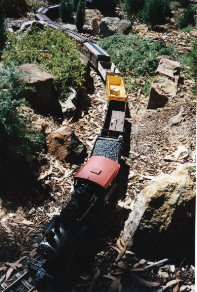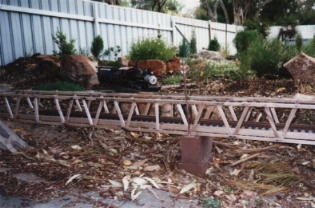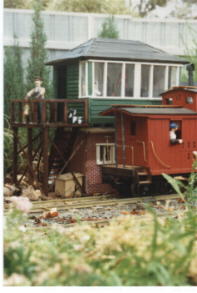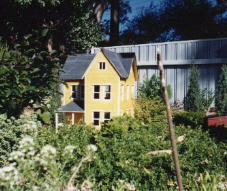 Updated March 14,1998
Updated March 14,1998
TOENAIL RIDGE SHORTLINE--ROOTS
In the latter half of the 19th. century, gold fever hit the United States. Men flocked to the west, hearing of mammoth strikes from Colorado to Alaska. Tens of thousands took any method of transport west to seek their fortunes and a few succeeded beyond their wildest dreams, but most soon found themselves with only the clothes they stood up in. One of the latter was Emmett Selby, a young veteran of the Civil War from Davenport, Iowa, the youngest son of an Irish dirt-farmer. He had sold everything he had to travel to the great western dream, and had battled his way across Nebraska and Utah heading to the Oregon Territory. But because of the lack of rapid communication, he soon found that new arrivals at the big strikes would find all claims taken or the lode mined out, or reports grossly exaggerated and the finding of nuggets relayed as the finding of reefs.
Emmett found occasional work as a laborer or stable-hand, drifting from one boom-town to the next as his meager finances allowed. Conservation was not a word in the lexicon of the late 19th. century miner and no thought was given to the land or its appearance. Great swathes of understory and trees were removed and top-soil discarded to reach the elusive gold. Streams were sewers and mud sluices and heavy metal runoff from refining tainted the rivers. But not all areas of the mountains were exploited, and valleys were left untouched after prospectors had inspected them.  Emmett slowly became aware that surrounding the mud and soot and ordure of mining camps was a land of benign climate, ample rainfall and verdant soil. He accepted that he was not going to become rich working for others and so, like his forbears, he turned to the land. In a matter of months he had cleared a smallholding and begun construction of a log cabin. He had also managed to get 100 lbs. of seed potatoes from local Indians who had salvaged them from a wagon train. By the end of his first year he was supplying potatoes and meat to the local miners, charging top dollar for his produce but still undercutting by a large margin the extortionate amounts demanded by the wagon provisioners from Seattle.
Emmett slowly became aware that surrounding the mud and soot and ordure of mining camps was a land of benign climate, ample rainfall and verdant soil. He accepted that he was not going to become rich working for others and so, like his forbears, he turned to the land. In a matter of months he had cleared a smallholding and begun construction of a log cabin. He had also managed to get 100 lbs. of seed potatoes from local Indians who had salvaged them from a wagon train. By the end of his first year he was supplying potatoes and meat to the local miners, charging top dollar for his produce but still undercutting by a large margin the extortionate amounts demanded by the wagon provisioners from Seattle.
By the time the gold boom had passed, the Territory was being settled by people from the east who had heard of the open spaces and the farm land waiting for development. Within a decade the area was a scattering of cleared land, crops and hamlets, and productivity in the lush growing conditions was such that local requirements were more than satisfied and the farmers looked for new markets for their produce. The transport of the day was the horse-drawn wagon, and the roads little more than muddy wheelruts thru the trees. In the east and in the older western regions the coming of the steam engine had revolutionized marketing, with fresh produce available in cities in days instead of weeks. Accordingly, the local residents of the region, now know as Selbyville, began agitating for a railroad spur from the west coast to service their valley. A public subscription was begun, led by Emmett Selby, and presentations were made to the infant legislature of the Territory. The case of the residents was bolstered by discovery of silver in workable quantities in the near hills. Subsequently, a right-of-way was soon in the initial stages of surveying. It was determined that the line would be of 3'6" gauge, with interchange at Rowel Flat, a valley a few miles from Selbyville, where water and lumber were available in quantity. The line would follow the valley, at times passing thru narrow gulches until it reached Fenster, the burgeoning site of a dairy industry. The right-of-way ran thru mostly undulating country until it came to an un-named granite and basalt range. The survey team investigated a number of alternate routes to get the line past this obstruction, but short of a twenty mile detour, they determined that the only way thru was a ledge blasted out of the cliff face with the line clinging precariously above a sheer drop, a cliff so steep that it looked like an artificial stone wall. The head surveyor noted in his day journal "It is my opinion that the only way we will get a locomotive past this ridge is by the engineer holding on with his toenails." Thus the name Toenail Ridge was born.
Typical of late 19th. century narrow-gauge railways, the right-of-way was cleared, levelled and trackage laid in rapid time. An irony of the project was the total bypassing of Selbyville, it having been decided by the now board of directors of the Toenail Ridge Shortline that the farming village would not generate sufficient income to warrant the expense. This was not a matter of concern to Emmett Selby as he had the previous winter absconded with the wife of the head surveyor and was believed lost at sea on his way to Australia, where gold had been found.
An irony of the project was the total bypassing of Selbyville, it having been decided by the now board of directors of the Toenail Ridge Shortline that the farming village would not generate sufficient income to warrant the expense. This was not a matter of concern to Emmett Selby as he had the previous winter absconded with the wife of the head surveyor and was believed lost at sea on his way to Australia, where gold had been found.
The Toenail Ridge Shortline was isolated from the outside world in the first decade of the 20th. century when its interchange line, the Portland and Great Eastern was forced into liquidation following speculation in Australian gold. Fortunately, road transport had developed to the point where Rowel Flat could still onship produce and a road could not be economically cut over Toenail Ridge. The future of the Shortline seemed secure. Car-loads were regularly provided in the form of Douglas fir, milk and the ubiquitous potatoes. Sheep and cattle grazed in the upland meadows and provided a small but vital meat market in Fenster. A thriving cottage industry in cheese provided the occasional crate for trans-shipment to San Fransisco, where a totally un-deserved cult following had developed for this dairy comestible.
As the century entered its third decade, little had changed in the area of the Toenail Ridge. The Great War had made little impact on this isolated area, a slight increase in demand
for beef and cheese the only marked influence. The local people read the news from outside their valley in the weekly Rowel Flat Examiner, but only after they had digested the local news and produce prices. The Shortline never exactly flourished, but was in daily if sometimes irregular use and was accepted as a part of local life and given no more thought than any other utility. The local never ran to time but was never too late either, except in the spring of '21 when the bridge abutments under the Wibley truss bridge washed away, leaving the little Porter No. 5 balanced precariously between a rock and a hard, wet place. In places the old narrow-gauge track-bed settled and the track resembled an ocean wave, but with an average speed under 15 mph, no one ever complained, and besides, the rocking motion helped the milk to churn, shortening the maturation process of the cheese at Fenster.
The local never ran to time but was never too late either, except in the spring of '21 when the bridge abutments under the Wibley truss bridge washed away, leaving the little Porter No. 5 balanced precariously between a rock and a hard, wet place. In places the old narrow-gauge track-bed settled and the track resembled an ocean wave, but with an average speed under 15 mph, no one ever complained, and besides, the rocking motion helped the milk to churn, shortening the maturation process of the cheese at Fenster.
Around 1922 a second 10-wheeler loco was purchased to pull the coaches of the weekly varnish. It's arrival at the line-head was a marvel of the day. It was bought very second hand from the Tweetsie in the South and trans- ported to Seattle by steamship. There it was loaded onto a reinforced flat car, with its tender on another, and railed south on the standard gauge to Portland. From there it began a seven week journey by road, hauled by a combin- ation of steam traction engine, motor truck, draft horses and,when the early rains hit, all of the above. Its arrival at Rowel Flat caused a bigger turnout of the locals than when Teddy Roosevelt whistlestopped in New Hoosier other side of the range back in grandpa's day.
In '29, the world came to an end outside of the Toenail Ridge valley, work stopped, people starved, business folded, money evaporated. But in the valley, the world continued with not a lot of change. The exports dried up, but since folks weren't buying in much, they absorbed most all of their produce themselves. They had all experienced winters - if not in Rowel Flat then certainly back east - when you couldn't get out of the house for days, and this was treated as just a larger version of that. Close the doors, stock the cellar and pull the community in after you. The train kept running, still with dairy products and meat, but now its cartage was paid in kind rather than in cash. It was a brave man who would accept a check, but a haunch of bacon was good for transport to Fenster any day. Coal to fuel the locos became scarce and then it was all gone, but it doesn't take a lot for a knowledgeable engineer to get steam up with wood, and in this part of the world wood grew on trees. A man out of work could always get a meal and a bed for helping to unload a box-car or lending his muscles to repairing a washout.
The exports dried up, but since folks weren't buying in much, they absorbed most all of their produce themselves. They had all experienced winters - if not in Rowel Flat then certainly back east - when you couldn't get out of the house for days, and this was treated as just a larger version of that. Close the doors, stock the cellar and pull the community in after you. The train kept running, still with dairy products and meat, but now its cartage was paid in kind rather than in cash. It was a brave man who would accept a check, but a haunch of bacon was good for transport to Fenster any day. Coal to fuel the locos became scarce and then it was all gone, but it doesn't take a lot for a knowledgeable engineer to get steam up with wood, and in this part of the world wood grew on trees. A man out of work could always get a meal and a bed for helping to unload a box-car or lending his muscles to repairing a washout.
 The Great Depression saw the end of many back-woods lines, especially those that based their existence on mining and logging. Motor transport took loads away and the small railways wilted due to lack of custom. Not so in Toenail Ridge. Because of the sheer cliff and the narrow canyons, the rail continued to serve the little communities long after comparable tracks had been pulled up. Some roads invaded the valley, but the cars that ran on them were brought in by the Toenail Ridge Shortline. Rod from the General Store bought a new model-A pickup for deliveries, and that was delivered on a flat-car from
Rowel Flat after being driven from Portland. Most folks just used the daily combine to travel from one hamlet to the next, and walked or rode on horse-back in their local community. Because of its geography, surrounded by wall-like mountains and the unscalable Toenail Ridge, the valley is like a land-locked island, its inhabitants mostly self-sufficient and content in their isolation. Occasionally they are discovered by travellers or itinerants, and now and again a local resident moves into the real world outside, but in general life changes little and the pace is the same now as it was in the 20's.
The Great Depression saw the end of many back-woods lines, especially those that based their existence on mining and logging. Motor transport took loads away and the small railways wilted due to lack of custom. Not so in Toenail Ridge. Because of the sheer cliff and the narrow canyons, the rail continued to serve the little communities long after comparable tracks had been pulled up. Some roads invaded the valley, but the cars that ran on them were brought in by the Toenail Ridge Shortline. Rod from the General Store bought a new model-A pickup for deliveries, and that was delivered on a flat-car from
Rowel Flat after being driven from Portland. Most folks just used the daily combine to travel from one hamlet to the next, and walked or rode on horse-back in their local community. Because of its geography, surrounded by wall-like mountains and the unscalable Toenail Ridge, the valley is like a land-locked island, its inhabitants mostly self-sufficient and content in their isolation. Occasionally they are discovered by travellers or itinerants, and now and again a local resident moves into the real world outside, but in general life changes little and the pace is the same now as it was in the 20's.
Emmett Selby was born on a small dirt-farm in Mt.Joy, Iowa in 1844. He was the youngest son of Irish immigrants Patrick and Sheila who had journeyed from County Cork to New York and then followed the wagon trains west seeking their own parcel of ground. They found the rich black soil of the prairie land immediately west of the Mississippi and set down roots, carving a farm from what was wilderness. Their nearest market was about 10 miles to the south, Davenport, even then on its way to becoming a large regional center.
With 7 older brothers he knew as he grew up that his future did not lay on the farm. He attended as much schooling as the harsh winters and chores permitted him, and then ran away from home on the day he turned sixteen to join Jackson's men marching to war from Wisconsin. He served as an infantryman long enough to realise that he would rather be somewhere else. At the first opportunity he managed to stowaway on a north bound Ohio river steamer. He picked a fight with an engine-hand after he was discovered and succeeded in getting his jaw broken. This became his war wound. On arrival in Dayton, he was welcomed as a young hero, received medical care while he healed and eventually a job as a stable-hand for the livery stable that outfitted pilgrims travelling to their respective Valhallas in the West. When word broke of gold strikes in the Far North-west, Emmett took his possessions and one of his employer's horses and joined the next wagon-train heading to Nebraska. As he progressed across the Plains, word regularly came of fortunes available just for the picking up in the gold-boom towns. Men deserted families and friends to rush to the setting sun, and amongst their number was Emmett. He stopped at the old homestead long enough to empty the savings jar of his now widowed mother, and resumed his quest.
As he progressed across the Plains, word regularly came of fortunes available just for the picking up in the gold-boom towns. Men deserted families and friends to rush to the setting sun, and amongst their number was Emmett. He stopped at the old homestead long enough to empty the savings jar of his now widowed mother, and resumed his quest.
Emmett in these early years did not show promise of the hard working potato farmer that he would become in the valley of Toenail Ridge. Selbyville historians have supposed a religious conversion by the pilgrims with whom he travelled, or perhaps the influence of a good woman. Neither of these suppositions was in fact the truth. Emmett heard a story from a cowhand in Utah, about a young bull and an old bull.The young bull wanted to rush, the old bull just walked and got everything he wanted. Emmett found within himself patience, especially after he had established himself as an honest, hard-working provider. As the valley he had founded grew in population, and the hamlet named after him underlined his importance to the community, he established the Bank of Toenail Ridge, with himself as president. It was most likely this position that induced the wife of the head surveyor to abscond with him. Folks weren't too upset about the bank president leaving with his carpetbag bulging, because most of the money that accompanied him came from miners deep in the hills rather than the local farmers, and everyone knew what no-accounts miners were. The miners raised some fuss when they got back to the bank and found it derelict, but Emmett had thoughtfully left money and instructions for a case of good red-eye whiskey at the saloon, so most of the miners finished up toasting his health.
Evidence has come to light in latter years that Emmett Selby was not in fact washed overboard on his way to Australia. Fair skinned natives with the surname of Silpie have recently been contacted in the Fijian Island group, who trace their heritage to a white god who flew from a ship one night and settled a village of native young maidens. He was best remembered for his prodigious number of off-spring and his extreme distaste for native potatoes.
Follow the links below to read the continuing story of Emmett Selby and the Toenail Ridge Shortline.